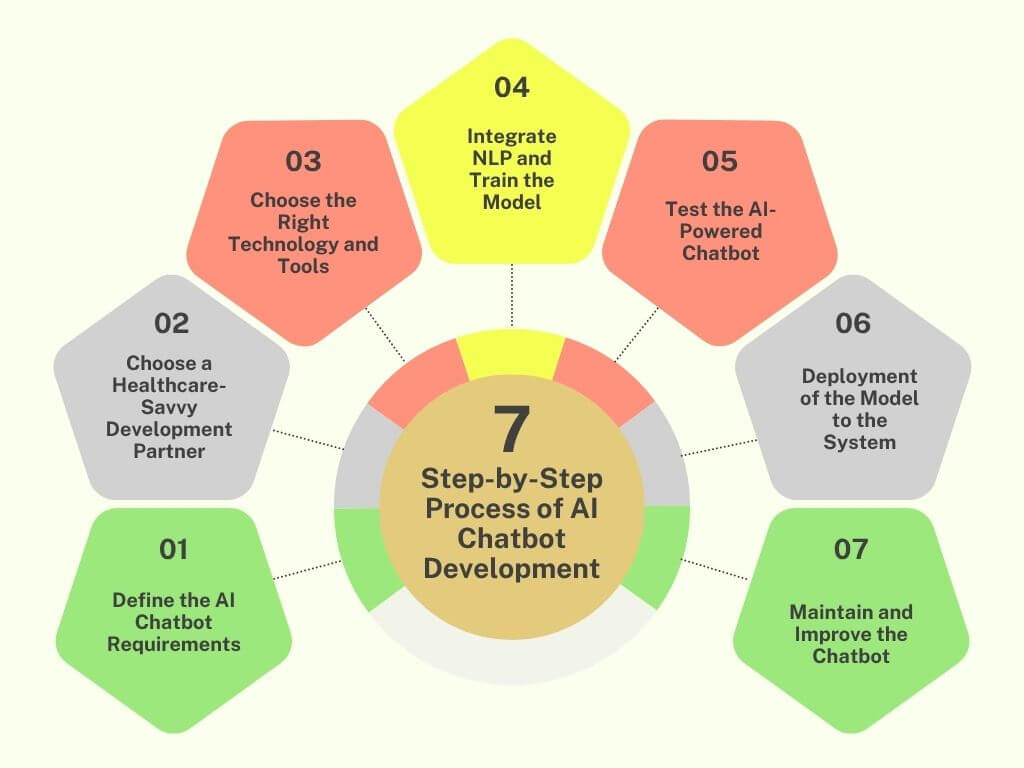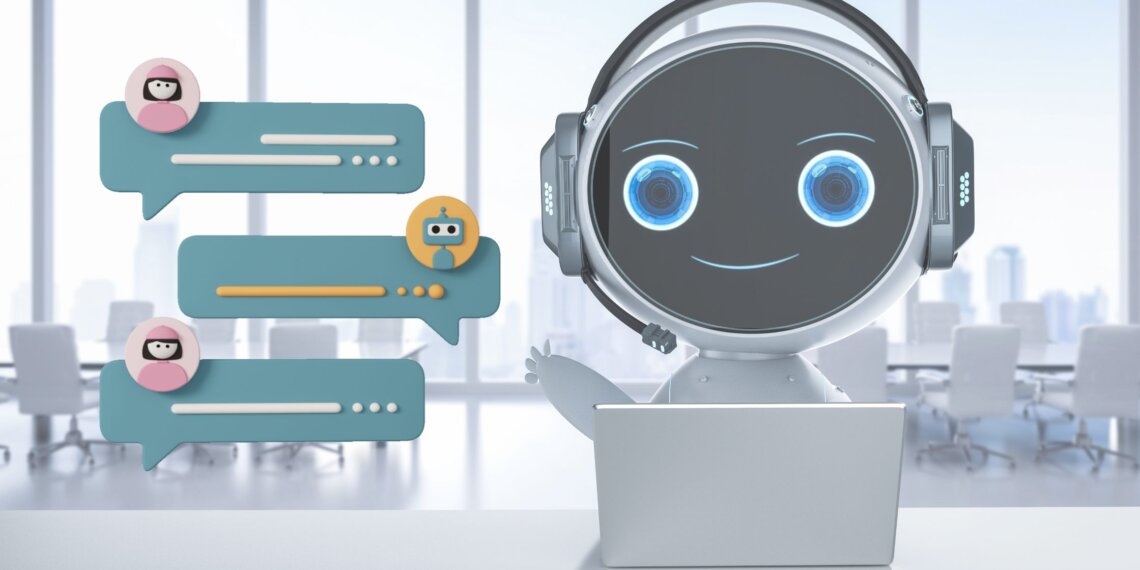Table of Contents
AI chatbot development has become a strategic priority for businesses aiming to improve customer support, streamline operations, and scale service without increasing costs. Whether you’re in a B2B or B2C environment, intelligent chatbots offer real-time assistance, automate routine interactions, and enhance user satisfaction, day or night.
But building a chatbot that goes beyond scripted replies and can truly understand, respond, and resolve complex queries takes the right blend of technology, planning, and customer insight. In this complete guide, we’ll walk you through the essentials of AI chatbot development, covering core technologies, key challenges, and practical steps to create chatbots that deliver measurable value across industries.
Key Benefits of AI Chatbot Development for Businesses
Businesses investing in AI chatbot development gain a competitive edge through faster customer support, reduced operational costs, and improved user engagement. With the help of professional Chatbot App Development Services, companies can build scalable, intelligent solutions tailored to their specific needs, whether for sales, support, or internal operations.
For Users
Fast Response to Customer Inquiries
When the user has inquiries, they bring in the questions in the form of intent. That is where the chatbot ensures to reply in the form of a response encompassing the information the user needs. Not only that, these responses are received by the users fast enough, within minutes, to make better upcoming decisions.
Provides Personalized Suggestions
Considering that these conversational AI solutions work on data, the more data you feed in, the better and more personalized the results you get. The same is the case with the users who utilize the solution and input data for customized suggestions.
Multilingual Issue Resolution
Since not everyone speaks the same language, the multilingual options of chatbots work for everyone. For instance, if a user speaks a different language, they can change the module and resolve the issue or get responses based on their language.
24/7 Assistance
Last but not least, benefits in terms of users are that these models are available to the general masses 24/7 and enable assistance around the clock. Being available to users at all times, AI-powered chatbots have changed the issue resolution game.
For Companies
Enhancing Customer Engagement
Before AI-powered chatbots, most consumer questions, apprehensions, or objections mandated a human touch. Nonetheless, AI-powered chatbots can automate operations, disentangling workers from redundant assignments. They can eliminate extended wait periods in phone-based customer support as chatbots are accessible to numerous users, improving the customer experience by promptly handling their inquiries and situations.
Operational Cost Reduction
AI-powered chatbots can diminish 24×7 staffing expenditures or even eliminate after-hours staffing expenses. Your chatbots can seamlessly manage most inquiries. You can optimize approaches that previously depended on human interaction, benefiting your attendants by enhancing their user incidents with customers and downsizing employee turnover.
Customer Service Increment
24/7 customer service staff can lose their keenness when they spend unreasonable time answering redundant queries. By utilizing chatbots to handle routine queries and referring them when more discernment is required, you can employ your staff when creativity and effort are most valuable, making their endeavors more rewarding.
Types of AI Chatbots and Their Use Cases
Different types of AI chatbots serve different purposes, ranging from rule-based bots for handling simple tasks to advanced AI-driven chatbots for complex conversations. Choosing the right type depends on your business needs, target users, and budget. While exploring the Artificial Intelligence Development, it’s important to consider how custom AI chatbot development can deliver more tailored and effective solutions for specific industries or workflows.
Rule-Based Chatbots
A rule-based chatbot is an AI system that works on the premise of conversations based on a preconceived set of rules and pedagogy. Unlike AI chatbots, which use machine learning and NLP to yield replies, rule-based chatbots heed straightforward conventions developers concoct to specify how they should interact with users. These guidelines and rules injunction the chatbot’s conduct, retorts, and movements in diverse scenarios.
AI Chatbots
An AI-based chatbot employs the most artificial intelligence and NLP in vigorous and contextually appropriate conversations with users. It comprehends data, comprehends user intent, and adjusts to various queries. Unlike rule-based counterparts, AI chatbots yield comebacks unassisted, suggesting a more human-like and adaptable interaction. Their abilities confine comprehension of context, opinion, and patterns, improving user experiences across multiple platforms.
Hybrid Chatbots
Hybrid chatbots incorporate the dependability of rule-based reactions with the adaptability of AI-driven practices to assemble a universal and context-aware conversational experience. They can provide thorough answers based on pre-set rules while utilizing NLP to capture the user’s objective and context. This assortment permits hybrid chatbots to present more unpretentious and precise dealings in procedures where straightforward rules might not cover every possibility.
Virtual Assistants
Virtual assistants are progressive chatbots that strive to deliver more thorough support and services. They frequently have natural language interpretation abilities and can materialize reminders, transmit emails, provide weather reports, etc. AI chatbot solutions include Google Assistant, Siri, and Amazon Alexa. These technologies also demonstrate the growing role of AI in Real Estate, where virtual assistants help schedule property tours, answer buyer queries, and streamline client communication.
Interactive Voice Response (IVR) Systems
IVR systems utilize voice prompts and keypad interfaces to guide users through menu alternatives, permitting them to complete tasks or access information. While often connected with phone-based systems, IVR can be incorporated with conversational AI platforms to equip improved and instinctive voice interactions.
Choosing the Right Platform for AI Chatbot Development
Choosing the right platform is a key step in successful AI chatbot development. The platform you select influences your chatbot’s flexibility, integration capabilities, and long-term performance. From open-source tools to enterprise-grade solutions, each option has unique benefits and trade-offs. In the context of modern chatbot application development, it’s important to evaluate platforms based on ease of use, scalability, and support for advanced AI features.
Popular AI Chatbot Development Platforms
| # | Platform | Description | Strengths | Considerations |
| 1 | Microsoft Azure AI Bot Service | Integrates deeply with Microsoft Azure, offering a full suite for bot creation. | Pre-built templates, sample bots, easy Azure integration. | Requires technical expertise for setup and integration. |
| 2 | Amazon Lex | AWS’s serverless platform for conversational AI bots. | Drag-and-drop interface, strong AWS integration. | May need extra tools for complex features. |
| 3 | Google Dialogflow | Known for strong NLP and ease of use. | User-friendly, HIPAA-compliant with Google Cloud Healthcare API. | Limited for advanced customization. |
| 4 | GPT-based Solutions | Uses generative AI for dynamic, context-aware conversations. | Handles unstructured data, supports semantic search and personalization. | Needs specialized development expertise. |
| 5 | IBM Watson Assistant | Enterprise-level AI with advanced NLP and analytics. | Highly customizable, supports multi-channel communication. | Complex for beginners; higher scaling costs. |
| 6 | RASA | Open-source platform offering full control over bot behavior. | Flexible, supports various NLP tools, and has strong community support. | Requires significant technical knowledge and development time. |
Step-by-Step Guide to AI Chatbot Development
Building a chatbot involves more than just coding. It requires careful planning, the right tools, and a clear understanding of user needs. In this section, we’ll walk through the key stages of AI-based chatbot development, from defining goals and choosing a platform to designing conversations, testing, and deployment. Each step plays a vital role in creating a chatbot that’s intelligent, reliable, and aligned with business objectives.

1. Define the AI Chatbot Requirements
Start by outlining the chatbot’s goals, user needs, and key features. For example, AI Chatbots in Healthcare may focus on symptom checking, appointment booking, or patient FAQs.
2. Choose an AI Chatbot Development Partner
Select a chatbot development company with experience in healthcare to ensure compliance, data security, and relevant features are built in from the start.
3. Choose the Right Technology and Tools
Selecting suitable platforms, frameworks, and APIs is essential to support chatbot functionality, integration, and performance. The choice depends on your requirements for scalability, customization, and long-term support. This can be assisted with the help of AI experts who have insights into chatbot development.
4. Integrate NLP and Train the Model
Natural Language Processing (NLP) allows the chatbot to understand user input and respond intelligently. Proper training with real-world data at the hands of AI chatbot development professionals improves accuracy and conversational quality over time.
5. Test the AI-Powered Chatbot
Thorough testing by testers ensures the chatbot performs well under different conditions. It helps identify bugs, refine responses, and validate performance before full deployment.
6. Deployment of the Model to the System
Once testing is complete, the chatbot is integrated into the business environment by the deployment team, whether it’s a website, mobile app, or internal system, ensuring seamless user interactions.
7. Maintain and Improve the Chatbot
Continuous monitoring and updates are essential to keep the chatbot effective. A trusted AI chatbot service provider focuses on adding new capabilities, improving response quality, and applying feedback.
Key Takeaways for Successful AI Chatbot Development
- Clearly define your chatbot’s goals, target users, and core functionalities before development begins.
- Choose a development partner with proven AI expertise and industry-specific knowledge.
- Prioritize scalability, data security, and integration with existing business systems (like CRMs or ERPs).
- Focus on user experience—design natural conversations and intuitive interactions.
- Continuously test, gather feedback, and improve the chatbot to keep it effective and relevant.
- Invest in long-term support and updates to align with evolving business needs and technologies.
What Factors Influence Chatbot Development Cost?
When planning a chatbot project, it’s important to understand what goes into the overall development cost. Prices can vary depending on whether you’re building a basic bot or a more advanced AI agent. Just like estimating the cost to build an app, the clearer your goals, the easier it is to determine the investment.
One major factor is complexity. Simple bots with scripted responses are more affordable, while intelligent AI agents with natural language understanding and learning capabilities require more time and resources. More advanced features mean higher development costs.
Location of the development team also matters. Developers in different regions charge different rates, which can significantly impact your chatbot development cost. Balancing quality and budget is key to a successful outcome.
Lastly, the platforms and systems you want to connect your bot to can influence the price. Integrations, analytics, and multi-channel support add value but also increase complexity. Planning ahead helps control costs and avoid surprises.
Estimated Chatbot Development Cost by Region
| Region | Estimated Cost (USD) for Basic to Advanced Chatbots |
| United States | $15,000 – $100,000+ |
| Western Europe | $12,000 – $80,000+ |
| Eastern Europe | $7,000 – $40,000 |
| Southeast Asia | $4,000 – $20,000 |
| Latin America | $5,000 – $30,000 |
What are enterprise chatbots?
Enterprise chatbots are advanced software programs designed to help large businesses automate conversations and tasks. These chatbots use technologies like artificial intelligence and natural language processing (NLP) to understand and respond to user questions, just like a human would. They are often the result of strategic Artificial Intelligence Development efforts tailored to business needs.
They are commonly used in areas like customer service, IT support, HR, and sales. For example, an enterprise chatbot can answer customer queries 24/7, help employees reset passwords, or assist in processing internal requests. Beyond the corporate world, there’s also growing use of AI Chatbots in Education, helping students with course guidance, answering academic queries, and providing learning support.
Unlike basic chatbots, enterprise chatbots are more powerful and scalable. They can handle complex workflows, integrate with business systems (like CRMs or ERPs), and manage large volumes of data. This helps companies improve efficiency, reduce costs, and offer better experiences to both customers and employees.
Key Function of Enterprise Chatbots
- Customer Support Automation
- Internal Workflow Automation
- System Integration
- Data Collection & Reporting
- Multilingual and Omnichannel Support
Types of Enterprise Chatbots
- Customer Service Chatbots
- HR Chatbots
- IT Helpdesk Chatbots
- Sales and Marketing Chatbots
- Internal Operations Chatbots
- Finance and Accounting Chatbots
Benefits of Enterprise Chatbots
- 24/7 Availability
- Cost Savings
- Improved Efficiency
- Consistent Responses
- Better Data and Insights
- Enhanced Employee Experience
Use cases of enterprise chatbots
- Customer Support Automation
- Helpdesk Support
- HR and Employee Self-Service
- Sales and Lead Generation
- Internal Workflow Automation
Why Choose AppsChopper as Your Trusted AI Chatbot Development Agency?
At AppsChopper, we pride ourselves on being a reliable AI chatbot development company in USA, delivering cutting-edge conversational AI solutions tailored to business needs. Whether you’re integrating AI into your CRM or launching an intelligent assistant for customer support, our expertise in machine learning and natural language processing ensures impactful results.
We blend technical proficiency with strategic thinking, helping organizations across industries stay ahead of the curve with intelligent, responsive, and scalable chatbot solutions.
Frequently Asked Questions
Q. What are the benefits of using AI chatbots for businesses?
A. AI chatbots provide 24/7 support, reduce operational costs, and improve customer engagement. They automate routine tasks and enhance response speed across channels.
Q. How much does it cost to develop an AI chatbot?
A. The cost to develop an AI chatbot typically ranges from $5,000 to $50,000 or more. It depends on factors like features, platform, complexity, and integration needs.
Q. How long does it take to build an AI-powered chatbot?
A. Building an AI-powered chatbot can take anywhere from 4 to 12 weeks. The timeline depends on the bot’s complexity, features, and integration requirements.
Q. What technologies are used to develop AI chatbots?
A. AI chatbots are built using technologies like Natural Language Processing (NLP), machine learning, cloud platforms (e.g., AWS, Azure), and frameworks such as Dialogflow, Rasa, or IBM Watson.
Q. Are AI chatbots compliant with data protection regulations (e.g., GDPR, HIPAA)?
A. Yes, the AI chatbots are compliant with data protection regulations, considering that they utilize users’ data, whether structured or unstructured. They are to maintain the safety and security of data from breaches and cyber threats.








